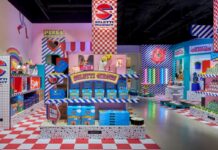In the new age of e-commerce, bricks and mortar retail has faced a huge challenge. Staying relevant and afloat when consumers can click to buy almost anything. As e-commerce exploded and then levelled out (contrary to all the headlines claiming the Death of the High Street) we’ve seen a resurgence of purchasing behaviour from bricks and mortar stores. But there seems to be a pattern emerging. Some brands are making it, and some are shutting their doors forever. Say goodbye to Mothercare, Body Shop, Wilco, Fenwicks… plus a further worryingly long list here.
We’re seeing in retail a variant of what was a significant consequence of Covid. The K-shaped economy emerged where retailers are either doing better than ever or rapidly declining. So, who’s doing better than ever?

Sara Parrish, Experience Strategy Director, Imagination
One consistency is that consumers are showing signs of experience-hunger. Retailers who are listening to this hunger are turning stores into experience destinations – an approach that we’re seeing not as a trend, but as part of the formula to thrive in the future of the retail sector.
The Shift from Transaction to Experience
E-commerce certainly revolutionised shopping, making convenience king. However, this shift also highlighted a significant gap once the e-commerce purchasing behaviour levelled out: the tactile, immersive, try-it-on experience that online shopping can never replicate. Consumers (especially Gen Z) are increasingly seeking experiences over acquiring products. This is reflected in their shopping habits, paired with increased sustainability concerns and exacerbated by a wobbly economy where non-essential spending is being cut in the household. This perfect storm is resulting in retail brands heavily reconsidering their bricks and mortar store offer. The store must now go beyond and focus on building value-centric connections.
As a result – physical stores aren’t just points of sale; they are platforms for storytelling, learning, entertainment, community, and brand immersion. Brands must lean into the Experience Economy and design experiences that feel personal, unique and deliver value across multiple touchpoints.
Learning from Brand Homes
We’ve seen an increase in brands reinventing themselves by reimagining stores as Brand Homes and visitor experiences. These are dedicated spaces where every element can reflect the brand’s ethos – not just push or display products. For instance, Starbucks Reserve, Apple Store Events and Tiffany’s Blue Box Cafe are all good examples of retailers leveraging their stores to create experiences and add value for customers.
We’re no longer seeing retail as a global churn-out exercise. Brands are thinking carefully about how they connect with local audiences. By ensuring they honour cultural and local nuances and remain relevant in their storytelling they can turn brand homes into destinations that people look forward to visiting.
Metrics that Matter
Within the experience economy, traditional metrics like sales per sq foot can no longer be the north star – and certainly don’t paint the whole story. For example, if a consumer goes into a store to try something on, and buy it later online, does that really mean the store ‘lost’ the sale? And it doesn’t highlight the long-term impact of in-store interactions such as building brand equity and price premiums into the minds of consumers.
Experience per sq foot should be a new consideration – with perhaps dwell time and customer lifetime value being better indicators of modern success. Brands should be measuring how deeply consumers engage with these environments, and how these interactions drive long-term loyalty and increased brand advocacy. A good example of this is Gentle Monster, who turned their eyeglass shop into an avant-garde artistic experience for shoppers.
Here are a few Case Studies of how different brands are creating experiences in retail:
- Dyson Demo Store: Combining educational and aesthetic components into the concept, Dyson sought to both show off their cutting edge tech designs and solve a customer pain point around not understanding how to use the ‘hair wrap’ product. The brand opened stores which allowed consumers to test products in real-world scenarios. This enhanced understanding and appreciation of the product and usability of the technology.
- GymShark: The brand was born as a pure e-comm brand that saw the value in having a bricks and mortar location – and following the successful launch of their flagship store is now opening its second permanent location. Its shop won’t be just for products. However, it’s for uniting a ‘conditioning community’ – from special events, workout classes and more.
- Canada Goose: Opened ‘The Cold Room’, which launched in Boston during the summer. The Cold Room is a sub-zero degree cold weather simulator that allows consumers to test their products in freezing temperatures, even in summer. This concept was so successful they’ve opened Cold Rooms in four more locations.
The ‘WIIFM’ factor
Brands that cut through the noise are ones that can successfully create quick and effective connections with their consumers and remain memorable.
Brands that do this really well have responded to the “What’s in it for me?” mindset by leaning heavily on the sense of community and ‘shared’ values they create with their customers. For example, Nike’s Fifth Avenue Flagship store gives back to consumers and the community by elevating their in-store storytelling and experiences. They’ve taken the time to understand what motivates their consumers, and turned this insight into moments of magic in-store, breaking the wall between consumer and brand and inviting the consumer to elevate what is otherwise quite a transactional experience.
Another example is the Rituals’ Amsterdam flagship which has a Deep Focus and Deep Rest experiences for the shopper to get the full wellness experience. Consumers who visit this brand are treated to a cultural moment which creates a sense of belonging that is long lasting.
The Path Forward
For retail brands who are looking to dip their toes into more experiential retail, start small but think big. Don’t look directly to your left or right, instead look across to different categories, sectors, and zoom out to see what new patterns are emerging in culture. Pilot some immersive experiences first in select locations, and measure their impact beyond immediate sales. Look at how these experiences influence your brand perception and customer loyalty. And finally, don’t be afraid to borrow concepts from culture, hospitality, or visitor attractions to create spaces that are not just ‘shops’, but experience destinations.
As we move forward – the boundaries between online and offline will continue to blur. Brands that succeed will be those that ask ‘why’ and ‘how’ before they begin designing, tapping into the experience economy to drive not just hard commercial value, but increase brand equity and build memorability in a highly competitive space
















